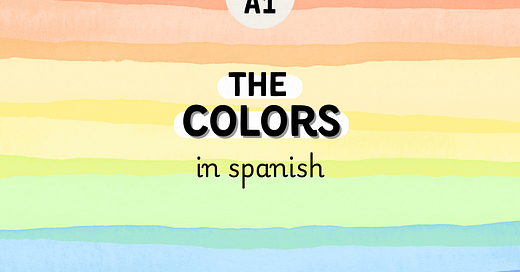Colors in Spanish: A Complete Guide with Examples and Exercises 🎨🌈
Colors are an essential part of any language. In Spanish, learning colors not only helps you describe objects, clothing, and nature, but it also teaches you important grammar rules! In this guide, you'll learn:
✅ Basic colors in Spanish
✅ How to make colors agree with gender and number
✅ Exceptions and irregular colors
✅ Useful expressions with colors
✅ An interactive quiz to test your knowledge
1. Basic Colors in Spanish 🎨
Let's start with the most common colors:
🔴 Rojo – Red
🔵 Azul – Blue
🟡 Amarillo – Yellow
🟢 Verde – Green
🟠 Naranja – Orange
🟣 Morado / Violeta – Purple
🌸 Rosa – Pink
⚫ Negro – Black
⚪ Blanco – White
⚪⚫ Gris – Gray
🤎 Marrón / Café – Brown
2. Gender and Number Agreement with Colors
In Spanish, colors function as adjectives, which means they must agree in gender (masculine/feminine) and number (singular/plural) with the noun they describe.
A) Colors that Change for Gender
Some colors end in -o in their masculine form and change to -a in their feminine form:
✅ El coche rojo (The red car - masculine)
✅ La camisa roja (The red shirt - feminine)
Other colors that follow this pattern: negro, blanco, amarillo, morado
B) Colors that Stay the Same
Some colors do not change based on gender:
✅ El libro azul (The blue book - masculine)
✅ La silla azul (The blue chair - feminine)
These colors include: azul, verde, naranja, gris, marrón, rosa, violeta
C) Making Colors Plural
If a color ends in -o or -a, add -s to make it plural:
✅ Los coches rojos (The red cars)
✅ Las camisas rojas (The red shirts)If a color ends in -e, -l, -n, or -r, add -es:
✅ Los pantalones azules (The blue pants)
✅ Las mochilas marrones (The brown backpacks)
3. Exceptions and Irregular Colors
Some colors are invariable, meaning they never change for gender or number. These include:
🟠 Naranja (Orange)
💜 Violeta (Violet)
🌸 Rosa (Pink)
Examples:
✅ El coche naranja / La blusa naranja
✅ Los zapatos rosa / Las faldas rosa
Even in plural, these colors stay the same!
4. Common Expressions with Colors
Colors are often used in idiomatic expressions in Spanish. Here are a few:
🔵 Ponerse rojo/a – To blush (literally "to turn red")
⚫ Verlo todo negro – To be pessimistic (literally "to see everything black")
🟡 Pasar la noche en blanco – To have a sleepless night (literally "to spend the night in white")
🟢 Tener luz verde – To have permission (literally "to have green light")
5. Interactive Quiz: Color Challenge! 🎯
Can you match the correct color in Spanish? Choose the right answer!
🚀 Want to Learn More?
📅 Book a 1-on-1 Spanish Lesson with me! 👉 Click here to schedule!
🎥 Subscribe to My YouTube Channel for more fun lessons! 👉 Subscribe Now!





